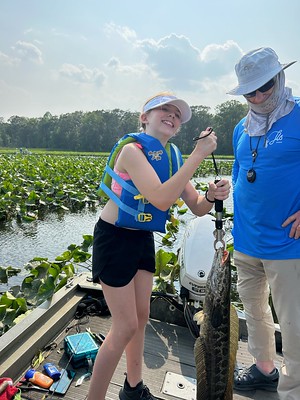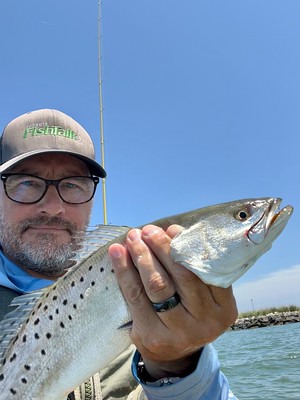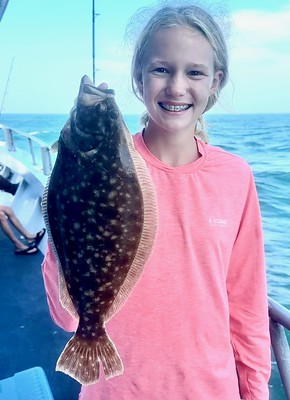Maryland Fishing Report – July 5
The summer season is now in full swing, and anglers are enjoying good fishing adventures with family and friends this week.
As we advise anglers every year, high summer air and water temperatures increase catch-and-release mortalities in striped bass. The Striped Bass Summer Fishing Advisory Forecast on the Maryland Department of Natural Resources website is an awareness campaign aimed to reduce striped bass mortality during times when conditions are most dangerous for the fish.
For that reason, all areas of the Chesapeake Bay will be closed to any targeting of striped bass from July 16 through July 31, statistically the hottest part of the year in Maryland.
Forecast Summary: July 5 – July 11:
Bay waters will continue to warm with a sunny week ahead, with low winds and a chance of rain Saturday and Sunday. Main Bay surface water temperatures have increased to about 80 degrees. Bay salinity is still above average. Some areas of low oxygen are present in bottom waters from Tolchester down to Love Point, as well as in the Potomac River from above the 301 Bridge down to Breton Bay. Avoid fishing below 20 feet in these areas. However, there are still plenty of cool, well oxygenated areas in the Bay to pursue gamefish, including the main Bay from Tolchester north to the Susquehanna Flats, and the area from Bloody Point south to the Virginia line.
Expect average flows all week. However, localized thunderstorms may increase flows in nearby waters. There will be above average tidal currents through Saturday as a result of the recent full moon on July 3. Expect average water clarity in Maryland’s waters. To see the latest water clarity conditions, check Eyes on the Bay Satellite Maps.
As always, the best fishing areas could be further refined by intersecting them with underwater points, hard bottom, drop-offs, and large schools of baitfish.
For more detailed and up-to-date fishing conditions in your area of the Bay, be sure to check out Eyes on the Bay’s Click Before You Cast.
Upper Chesapeake Bay
The Conowingo Dam continues its midday power generation schedule, bringing cool water to the lower Susquehanna River. Anglers are reporting striped bass action in the dam pool during the early morning while casting a mix of paddletails, jerkbaits, poppers, and crankbaits. Near the Susquehanna Flats there is some early morning and evening striped bass action along the edges of the channel. Northern snakeheads are protecting fry balls in the grass of the flats and sometimes can be enticed to strike a buzzbait or soft plastic frog.
The real striped bass action unfolds at the mouth of the Patapsco River. Boats are coming from as far away as the lower Bay to get in on the action. Most anglers are live lining with spot with excellent results. Jigging is a good option that gets you away from the fleet, as is trolling with umbrella rigs.
Non-offset circle hooks are mandatory for live-lining or using cut bait for striped bass, and their use helps reduce the mortality of released fish. Careful catch-and-release practices, which you can find on the Department of Natural Resources website, will also help reduce mortality during high summer water and air temperatures.
Spot can be found in about 15 feet of water at the mouth of the Magothy River south past the marina at Podickory Point, Sandy Point State Park, and the shallower west end of the Bay Bridge. Fishing for white perch is very good this week and anglers are catching a nice grade of white perch in the region’s tidal rivers and creeks. Anglers fishing in deeper waters are using bottom rigs baited with pieces of bloodworm or artificially flavored baits, minnows, or shrimp. Dropper rigs can be effective and casting small spinnerbaits, spinners, and jigs can be a fun way to fish in the morning and evening along shoreline structure.
A mix of blue and channel catfish are waiting for anglers in the deeper channel waters of all the region’s tidal rivers. A variety of fresh cut bait, chicken liver, clams, and shrimp all work well. Snakeheads can be found in thick grass in the tidal rivers and casting buzzbaits or frogs are a good way to fish for them.
Striped bass fishing in the middle Bay can be a tough nut to crack this week, either in the mainstem or the tidal rivers. There is some action with live-lining at the 35-foot drop off on the east side of the Bay Bridge, but the best opportunities are early in the morning on a running tide. Jigging near the bridge piers in the early morning hours is also a good option. Anglers are reporting some early morning and late evening action at the Poplar Island rocks, Thomas Point, and the shorelines of the Bay and tidal river for those casting poppers and paddletails. Anglers are also catching speckled trout – also known as spotted seatrout – in these same areas.
Fishing for white perch in the region’s tidal rivers, creeks, and Bay shorelines offers some fun action. The white perch are holding near deep structure such as oyster reefs, deepwater docks and wharfs, and breakwaters. Grass shrimp and pieces of bloodworm on a bottom rig is a great way to catch them any time of the day if the tide is running. In the morning and evening, casting small spinnerbaits or spinners near shoreline structure is a fun way to fish for white perch.
Striped bass fortunes are a bit sparse this week in the lower Bay. Recently the best fishing for striped bass has been in the tidal rivers although they have been stained from thunderstorm runoff. Hopefully these conditions are in the process of clearing. The good news is that anglers are catching speckled trout and slot size red drum while casting lures for striped bass along the shorelines of the Bay and tidal rivers. Topwater lures in the form of Zara Spooks are working well over grass beds and in stump fields. Casting paddletails and soft plastic jigs is also a good bet. Small bluefish are showing up at various locations in the lower Bay chasing schools of bay anchovies.
Increasing numbers of large red drum are moving into the lower Bay and the greatest numbers tend to be on the eastern side near the Target Ship, the Mud Leads, and the Middle Grounds. At times they can be spotted on depth finders, and anglers are dropping soft crab baits to them or jigging. Trolling large spoons behind inline weights will also work for this fun catch-and release fishery.
Anglers have been anxiously waiting for cobia to show up in greater numbers, and fishing for them is improving. Most are being caught while chumming and fishing with live eels at the deep end of a chum slick. Sight fishing is always one of the more exciting ways to fish for them and there are reports of success. Smith Point, Pocomoke Sound, and the Target Ship area are good places to look for cobia this week.
There is plenty of excellent fishing for white perch in the tidal rivers and creeks of the lower Bay. They can be caught in deeper waters by using pieces of bloodworm or artificial bloodworm baits on a bottom rig, or by casting small spinnerbaits, spinners, or jigs along shoreline structure. The early morning and evening tend to offer the best shoreline fishing opportunities. Spot and small croakers are also part of the mix when fishing in the deeper waters of the tidal rivers.
Recreational crabbers are out in force trying to fill requests for a crab feast for family and friends, and most have not been too disappointed. The Middle and Bush rivers are a good place to crab in the upper Bay this week. Kent Island, Eastern Bay, and the Miles, Wye, and lower Choptank rivers are good locations in the middle Bay. Little Choptank and the complex of tidal rivers on the western shore are all good places to set trotlines and strings of collapsible traps. In the lowerBay, the entire Eastern Shore offers good crabbing opportunities as does the St. Marys River. Chicken necks are the most commonly used bait, but razor clams will never disappoint.
The special trout management waters in western Maryland are offering some challenging but exciting fishing this week. Most of these areas have excellent populations of trout because they are catch-and-release only and many are restricted to artificial flies and fly-casting tackle. Flows are down, which is typical for the summer months, but stealthy approaches and light tippets can put the odds in your favor. Angler Bryson Meyers was fishing the North Branch of the Potomac recently for trout when he caught a new state record fallfish that weighed 3.01 pounds.
The upper Potomac River is also experiencing low summer flows, and this can make boating difficult. The low water conditions open opportunities for wading and casting to pools and eddies where smallmouth bass may be holding. In the early morning, poppers are a fun way to fish and as the day wears on, casting tubes, small crankbaits and swimbaits can work well.
Largemouth bass is always a popular target species for freshwater anglers during the summer. Anglers who are out during the early morning and late evening can be treated to shallow water topwater action near grass beds and the mouths of small feeder creeks. Frogs, buzzbaits, and poppers are great lures to use and in tidal waters northern snakeheads can be found in thick grass.
Later in the morning, casting spinnerbaits, jerkbaits and crankbaits along the edges of grass beds and deeper waters anglers can find largemouth bass in transition zones between the shallows and deeper waters. As the day wears on, largemouth bass will seek cool shade in deeper waters, under thick grass mats, or under overhanging brush, fallen treetops, and docks. Flipping whacky rigged plastics under these shaded areas or through floating grass mats can entice bass to pick up a bait.
Fishing for crappie can be a fun and relaxing way to fish with a simple minnow rig and slip bobber. One can cast near deep brush, fallen treetops, marina docks, bridge piers, and almost any kind of structure in water with some depth. Fishing for bluegills can offer some summertime fun, especially for kids with a worm and bobber rig. More experienced anglers can cast floating foam ants or small rubber-legged poppers with a light fly rod.
Following recent thunderstorms, surf fishing has been a bit lackluster lately, but anglers are catching a mix of kingfish, small bluefish, clearnose skates, and cownose rays.
At the inlet and Route 50 Bridge area, fishing for a mix of striped bass and large bluefish continues to be good for those casting soft plastic jigs and Got-Cha lures. The jetty rocks, bridge piers, dock piers and bulkheads are all good places to jig. Others are having good luck drifting cut baits in the current.
Flounder fishing is good this week when clear water can be found. The channels are the place to fish but just be very careful of large boat traffic. The largest flounder are being caught with live mullet, spot, and menhaden. Gulp baits can also be a good choice when targeting the larger flounder.
Outside the inlet and offshore, boats trolling inside of the 30-fathom line are finding Spanish mackerel and bluefish. The boats fishing the wreck and reef sites are experiencing good fishing for sea bass, triggerfish, and large flounder this week. Out at the canyons, the boats that are trolling are bringing a mix of bigeye and yellowfin tuna back to the docks.
“There are, as you have observed, a number of people who can only be happy while they are suffering. Some insist on physical misery, some on mental or spiritual. The fisherman is blessed, because he can and often does enjoy both kinds simultaneously.” – Ed Zern
Maryland Fishing Report is written and compiled by Keith Lockwood, fisheries biologist with the Maryland Department of Natural Resources.
Click Before You Cast is written by Tidewater Ecosystem Assessment Director Tom Parham.
This report is now available on your Amazon Echo device — just ask Alexa to “open Maryland Fishing Report.”







 1-888-373-7888
1-888-373-7888 233733
233733